|


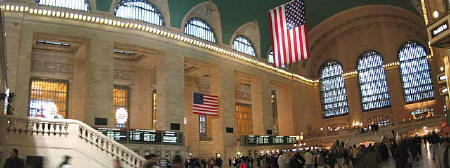
|
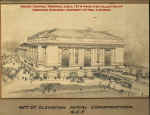 |
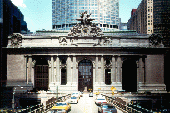 |
|
Photo courtesy of
Neil
Capanna
from the collection of
Abraham Stransky |
©
Frank English, MTA Metro-North Railroad
|
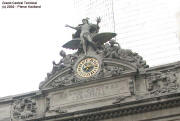 GRAND
CENTRAL TERMINAL GRAND
CENTRAL TERMINAL
By Pierce Haviland
Grand Central is a "Terminal", not a station, because trains terminate
there mainly on stub-end tracks. The existing building is not the first facility to be
built on 42nd street. Construction of the first building, called Grand Central Depot, was
begun in 1869 when Commodore Vanderbilt was in charge of the New York Central and Hudson
River Railroad. Work also began that year on a new connecting railroad from Spuyten Duyvil
to Mott Haven that would allow Hudson River Railroad trains to use Grand Central Depot.
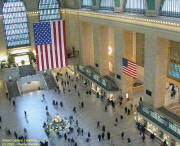 When the New York Central moved to the new Grand Central Depot in 1871, the old station
at 27th Street was bought by P.T. Barnum and converted into the first Madison Square
Garden. The current Madison Square Garden was built over the site of the old (and Grand)
Pennsylvania Station. Grand Central Depot was inadequate from the day it was completed in
1871 until it was replaced by Grand Central Terminal in 1913. When the New York Central moved to the new Grand Central Depot in 1871, the old station
at 27th Street was bought by P.T. Barnum and converted into the first Madison Square
Garden. The current Madison Square Garden was built over the site of the old (and Grand)
Pennsylvania Station. Grand Central Depot was inadequate from the day it was completed in
1871 until it was replaced by Grand Central Terminal in 1913.
Grand Central Depot
was actually three adjacent railroad buildings for the Hudson
River Railroad, The New York and Harlem and the New York and New
Haven railroads. If you arrived from New Haven on a trip to
Ossining, you would have to exit the New Haven portion of the
building and re-enter the Hudson River Railroad depot. When
traveling with baggage, this was a tremendous inconvenience. To
remedy this problem, the buildings were connected during a major
upgrade in 1898. At that time, Grand Central Depot was renamed
Grand Central Station, a name that has endured for many years and
is now retained by the subway station beneath Grand Central
Terminal.
Two problems doomed the old
facility: congestion and smoke from steam engines. To correct these problems a two level
terminal was built with third rail electrification.
Grand Central Depot, and its massive train shed ( a canopy over the tracks ) is now
gone over 80 years, but a part of the building has been preserved. Just behind the
southbound platform at Philipse Manor is a sculpture of a massive eagle. It once sat on
top of Grand Central Station. A duplicate, from the other corner of the building, has been
preserved at Phoenicia, New York, just off Route 28 as you enter the north end of the
village. While the eagle may not be worth the trip to Phoenicia, about 100 miles from New
York City, the Empire State Railroad Museum, also located in the town is an interesting
collection of railroad memorabilia.
Another eagle from Grand Central Depot made its way to a garden in Bronxville, New
York. The owners of this eagle have donated it to Metro North. It was restored at the
North White Plains shop. Moving the old sculpture without damaging it was a monumental
task. The Metro North wreck gang was up to the task. This eagle has returned to Grand
Central and will be perched outside the entrance on Lexington Avenue and 43rd Street.
The cost to construct Grand Central Terminal was a staggering $43 million. The price
was offset by the sale of "air rights" over the enclosed facility. Many majestic
buildings were constructed including the Waldorf Astoria Hotel. For many years, the
elevators in these buildings would be powered by third rail current provided by the New
York Central.
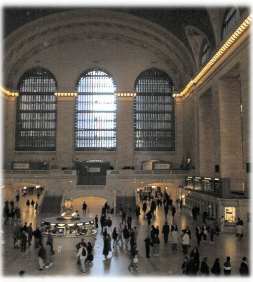 Grand Central remains a grand facility today. It almost suffered a fate similar to the
old Pennsylvania station. In 1968, the Penn Central corporation proposed an office tower
to be built over the building. The idea was not novel. When original proposals were made
to build Grand Central, the architectural firm of Reed and Stem proposed a 700' office
tower to be built above the building. Grand Central remains a grand facility today. It almost suffered a fate similar to the
old Pennsylvania station. In 1968, the Penn Central corporation proposed an office tower
to be built over the building. The idea was not novel. When original proposals were made
to build Grand Central, the architectural firm of Reed and Stem proposed a 700' office
tower to be built above the building.
When the office tower proposal was brought back by Penn Central, there was a great deal
of public outcry to save Grand Central. There was little hope that the building could be
saved until Jacqueline Kennedy Onnasis stood in front of the building and urged the
preservation of the historic site. Penn Central withdrew their plans and Grand Central was
saved and designated as a historic site.
Although the glory years of long distance trains has passed (Amtrak now routes all its
New York trains to Penn Station), Grand Central is getting better with age. Signals have
been computerized and a central control station has been built that directs trains on the
entire Metro-North system. A locomotive simulator facility was built in 1990 to train and
certify engineers. Another modern facility, in the old CBS studios, fosters employee
development with classroom, video and computer-based training.
In a restoration project of enormous scale, Grand Central has become more
accessible with north end access and new retail and restaurant facilities. The celestial
ceiling was restored to its original beauty. The marble was cleaned and repaired. The
beauty will not go unnoticed. In 2002, Metro-North
carried over 72 million passengers. That is a record that keeps getting
broken, surpassing previous numbers that were set during World War II in the heyday of
rail travel. Take Metro-North to its New York
Terminal and enjoy a Grand experience.
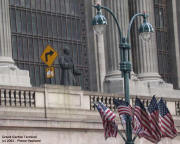 Although
the statue of Cornelius Vanderbilt stands proudly in front of Grand
Central Terminal, this was not its original home. The first location was
on the west side of Manhattan at the terminal of the Hudson River
Railroad. The Commodore seems to be directing traffic as vehicles on
Park Avenue make their way around this fine facility with a large hall
named in his honor. Although
the statue of Cornelius Vanderbilt stands proudly in front of Grand
Central Terminal, this was not its original home. The first location was
on the west side of Manhattan at the terminal of the Hudson River
Railroad. The Commodore seems to be directing traffic as vehicles on
Park Avenue make their way around this fine facility with a large hall
named in his honor.
All photos
and text on this page are copyright © Pierce Haviland
Please do not use them without permission.
 Photo Index
Photo Index
| Home |
Please mail your comments to:

Last updated
November 10, 2010
-

|